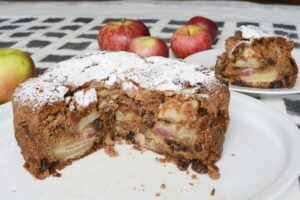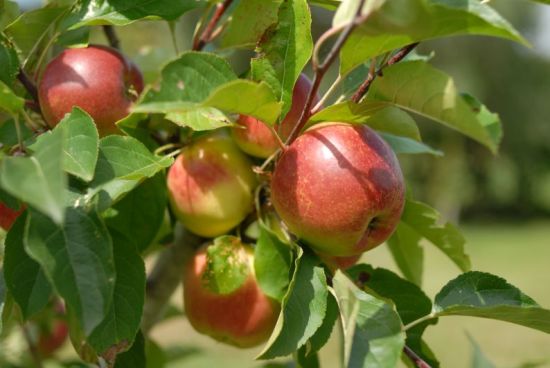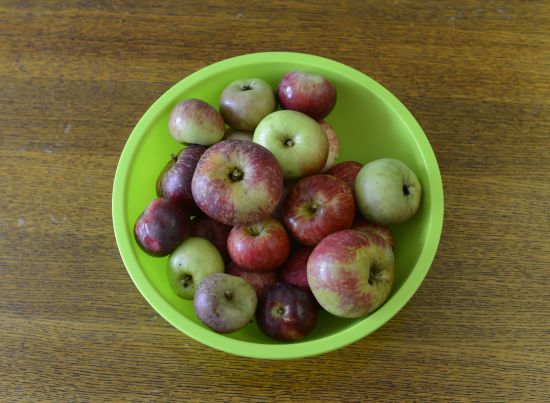
Little compares to biting into a crisp apple picked fresh from your own tree. Seemingly, when people have a good experience eating apples, they remember it as even better than it was.
Growing apples organically is easy if you follow a few basic rules, starting with selecting varieties that are inherently disease-resistant.
Just as important as selecting disease-resistant varieties is rootstock selection. We recommend a tree no taller than you can reach easily with a ladder. Generally the more dwarfing the rootstock, the sooner the tree will fruit (often two to three years from planting) and the larger the fruit will be.
The root systems of dwarfing rootstocks are relatively small or they’re brittle which means they can’t adequately anchor the tree, and they don’t have access to moisture deep in the ground. So, all dwarf trees should be staked and regularly watered.

When choosing apple trees, consider your climate. Your tree will produce more fruit and live longer if it’s suited to your area.
Most fruit trees, including apples, are delivered to you bare-rooted in June or July. If you buy a tree in a container, then you can plant as late as early spring.
Since apples, like most fruit trees, require mycorrhizal fungi on and around their roots, aim for a soil that has a lot more fungi than bacteria in it.
To increase insect predators on apple trees, plant a ground cover specially designed to attract beneficial insects. Comfrey, which is rich in calcium and draws minerals from subsoil, is great to plant under apple trees. Its flowers attract native bees which pollinate the apple blossoms.
Most cultivars need to be pollinated by a second compatible apple or crab apple within 1.5 km, that blooms at the same time. A few cultivars are self-pollinators. See table below.
Thin apples five or six weeks after blossoms drop – the tiny apples will be 2 to 2.5 cms in diameter. Thin to the biggest fruit, leaving one about every 15 cms. In every cluster of apple blossoms, there’s one in the centre that’s slightly bigger and slightly earlier than the others. Orchardists call this flower the ‘king blossom’. Because it opens a day or two before the others, the king blossom usually gets pollinated first and therefore produces the largest fruit. However, if the largest fruit is blemished, remove it and choose another. If there’s no real difference in size among the fruits, select the one with the thickest stem.
Many apple trees tend to bear heavily every other year, with little to no fruiting in between. Thinning shortly after blossoms fall helps reduce this tendency and results in more even harvests every year.

Apples are prone to codling moth. One way of trapping them is with our molasses mixture which works well because it traps both the male and female codling moth, unlike the pheromone traps you buy which only trap the male. Use 2-litre empty milk bottles. Cut two holes the size of golf ball on either side at the top of the bottle just under the lid. This is where the moths enter, attracted by the smell, and drown.
Into a bucket put…
5 cups water
1/2 cup molasses
1 cup cider vinegar
a few drops of dishwashing liquid
a few drops of ammonia (which helps to release the smell)
Mix well. Fill milk bottles about a quarter full and screw lids back on.
Pruning is important. Create an open vase shape to let light and air into the tree. Prune trees yearly in autumn to reduce the risk of apple canker, which forms in spring. Apple canker is a fungal disease which attacks the bark, causing a sunken area of decay and requires the branch to be removed.
Apples ripen from midsummer through late autumn. Early apples tend to ripen unevenly over several weeks. Late apples can all ripen the same day. If you have room for a few trees, you can select cultivars that ripen at different times and pick apples all season. Taste apples to decide when they are ready to pick. Skin colour and the first fallen apple may be good clues, but taste is the best method. If they taste starchy, they’re still green. Lift each fruit in the palm of your hand and twist the stem. If ripe, it will part easily from the twig without tearing. Handle apples with care so they don’t get bruised.
Apples vary greatly in their keeping quality. In general, late apples are better keepers than early apples.
Here are some reliable varieties:
Early = December-February
Mid-season = March-April
Late = April-June
| Initial | Early | Self-sterile | Pollinator: Gala, Golden Delicious, Granny Smith, Priscilla, Dayton, Freyberg |
| Jonathan | Early to mid-season | Partially self-fertile | Pollinator: Gala |
| Lobo | Early to mid-season | Self-sterile | Pollinator: Captain Kidd, Freyberg, Granny Smith, Jonathan, Liberty, Red Delicious |
| Captain Kidd | Mid-season | Self-sterile | Pollinators: Freyberg, Granny Smith, Liberty, Jonathan |
| Dayton | Mid-season | Self-sterile | Pollinator: Initial, Priscilla, Granny Smith, Freyberg |
| Freyberg | Mid-season | Self-sterile | Pollinator: Gala, Golden Delicious, Granny Smith, Priscilla, Red Delicious, Initial, Dayton |
| Gala | Mid-season | Self-sterile | Pollinator: Golden Delicious, Granny Smith, Priscilla, Red Delicious, Initial, Dayton, Freyberg |
| Golden Delicious | Mid-season | Self-fertile | |
| Priscilla | Mid-season | Self-sterile | Pollinator: Initial, Dayton, Granny Smith, Freyberg |
| Red Delicious | Mid-season | Self-sterile | Pollinator: Dayton, Freyberg, Golden Delicious, Granny Smith |
| Splendour | Mid-season | Self-sterile | Pollinators: Tydemans Late Orange |
| Kidd’s Orange | Mid-late season | Self-sterile | Pollinator: Golden Delicious, Granny Smith, Priscilla, Initial, Dayton, Freyberg |
| Liberty | Mid-late season | Partially self-fertile | Pollinator: Freyberg, Granny Smith, Jonathan, Priscilla |
| Granny Smith | Late | Self-fertile | |
| Tydemans Late Orange | Late | Self-sterile | Pollinator: Granny Smith, Jonathan, Priscilla, Red Delicious |
| Winesap | Late | Self-sterile | Pollinators: Freyberg, Granny Smith, Jonathan, Kidds Orange, Priscilla |
Website designed by www.thecornerstorecollective.com
Developed by Richard Hpa